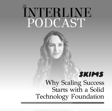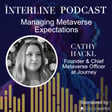Introduction to Interline Podcast 2023
00:00:12
Speaker
Hey, welcome to the first episode of the Interline Podcast for 2023.
00:00:17
Speaker
We've had a rollercoaster start to the year, we've been spotlighting the importance of technology at live events in Munich, Paris, and Las Vegas. And unfortunately that meant we got rolling on the podcast a little later than planned. But rolling we are, and we have two very different episodes headed your way in quick succession.
Impact of 3D Digital Products in 2022 and 2023
00:00:35
Speaker
One will be highlighting the ways machine learning is quietly becoming part of the infrastructure of fashion in some ways you might not expect, and that's coming soon. And today's show, which looks at how 3D and digital product creation came to define last year and what they're going to potentially deliver as part of broader digital transformation strategies in 2023.
Guest Introduction: Alison Cadair from Calypso
00:00:55
Speaker
My guest today is Alison Cadair, who's a DPC leader at Calypso who sponsored this episode.
00:01:01
Speaker
Allison's one of several experts have helped establish the Calypso practice as one of the leading digital product creation consultancies in the retail industry. From strategy to technology implementation and organizational change management, Calypso helps its clients break through the barriers of digital transformation, supports them in constructing the right DPC ecosystem to fit their needs, and ensures that they can rapidly accelerate their DPC strategies no matter their current maturity level.
00:01:27
Speaker
In DPC and beyond, Calypso helps companies to build the end-to-end solutions and connected ecosystems that allow them to digitally create, manufacture, and sell products. All of which means that when it comes to mapping out how technology, and especially DPC, influenced fashion in 2022, and where it promises to take us in 2023, Alison and I had a lot to talk about.
Tech Adoption Influenced by 2022's External Forces
00:01:50
Speaker
I want to talk a bit about last year in technology. Now, for the most part, brands are not adopting technology just for the sake of it, right? They tend to do it with either a challenge in mind that they're responding to, or they're doing it as a way to build towards a strategic vision. Both of those things are being shaped by external forces. They're being shaped by things outside the business. If you look back at last year, what external forces do you think
00:02:17
Speaker
exerted the strongest influence on the way fashion either adopted new technology or scaled the way it used pre-existing technology.
00:02:26
Speaker
2022 was an interesting year because we saw the culmination of all the investments made at the beginning of COVID start to be really employed by the brands that had made those investments and react to different challenges than we thought we were going to have to react to when we made those investments. So in 2022, we saw a lot of supply chain disruption, right? It was taking longer for us to get product to the consumer.
00:02:54
Speaker
And digital tools were really helpful there because we can accelerate the digital development process and make sure we're creating the right product. And that's a big one as well because inventory was also a big challenge in 2022. So designing the right product that the customer wants to buy and leveraging digital tools to do that was a big theme. And it was exciting to be able to use GPC and use the tools
00:03:19
Speaker
to solve different problems. And I expect that we'll continue to do that going into 2023. There's so much that we can do with digital samples, the connected data, et cetera, that I think as new problems come up, we'll continue to understand how modernizing the way we develop product can solve those problems with data and digital samples fully, but definitely minimize risk.
00:03:43
Speaker
I think that's a great way to look at it. It gives you the agility, the flexibility to react to changing circumstances. It gives you a way to prioritize core things like margin. It gives you a way to take advantage of new opportunities. There's a lot of possibility space that opens up when you're not beholden to just having to do everything the physical way.
00:04:07
Speaker
Yeah, and those external forces that you alluded to drive a lot of strategic vision for brands and we're in such an unpredictable space, right? If you had said in 2019 what 2023 would look like or 2022, I guess.
00:04:22
Speaker
none of us would have gotten it right. A lot of us were already looking into digital tools there to solve different problems. So I think as the strategic vision for brands keep changing, keep shifting in reaction to those external forces, we're going to keep shifting and keep developing and maturing and adopting digital technologies that will support business success and achieving business goals and those strategic visions.
Market Size and Ecosystem of DPC
00:04:49
Speaker
Now, we both, not solo, I know we're both working teams here, but we both put out detailed reports about how the fashion industry is moving along the maturity curve in digital product creation, DPC, in 2022. Now, selfishly, I'm just going to talk a little bit about our report first. I guess that's
00:05:07
Speaker
my prerogative as a host, but also it's fresh in my mind. I'd like to get your thoughts on it. Now, with that being our first ever DPC report, we set out to put together a baseline market analysis, which would give us the foundation to build on in future reports. And we put that together by looking exclusively, we really narrowed in on software licensing for solutions that live under the DPC umbrella. Now, within that fairly narrow calculus, we figure that DPC
00:05:37
Speaker
is in a market bracket that's already approaching technology segments that we think of as being like super mature and big enterprise like PLM. When you do a light for light comparison and you exclude surfaces and you just focus on software revenue. So to me, it's evidence that digital product creation is not kind of a small offshoot of technology for fashion. It's a pretty key component and it's a big segment in its own right. Does that mirror what you're seeing?
00:06:05
Speaker
The market size potential in DPC is big, and I think it's actually going to continue growing. In the last question, we talked about the risks that we're mitigating that we didn't predict, and I think there's going to be more of those in the future years that we're going to start seeing other ways to apply DPC, and the market will continue to grow. DPC is a key ecosystem for our clients, honestly.
00:06:30
Speaker
Important to call it an ecosystem. I use that word really intentionally because it's not just one tool. It's bigger than a single solution. And honestly, it serves a different purpose. With DPC, we're enabling creative decisions and making the assortment and really the secret sauce that makes retail what it is, where we iterate and get customer feedback and understand the designs we're bringing to market.
00:06:53
Speaker
So DPC is focused on supporting that area. So the toolset that we enable with DPC really feeds into a PLM, it complements the PLM, but they serve different parts of the same whole. So we do think that the market size for DPC is big and will continue to grow because it is how we are going to modernize bringing product to market in retail fashion.
00:07:18
Speaker
I think that's a great point. I think if you look at one as a system platform, PLM, and then you look at one, DPC, as a much broader ecosystem, it's important to see how one orbits the other. Because within DPC, within that ecosystem, you've got that whole point cloud of solutions that cover everything from digital materials to digital avatars to e-commerce utilization and all that kind of stuff that happens.
00:07:43
Speaker
like a huge raft of creative and commercial decisions that need to be taken based on a digital asset. But you don't need a place for the output of those decisions to live, right? You need a place for that data to go, you need a core. And that's where the two interact, I think, from my perspective.
00:07:59
Speaker
Yeah, and I think there's other parts of it that are just as important, talking about planning, for instance, connecting digital assets both to the product development side through the PLM and sourcing, and also on the other side to merchandising and how we can leverage those assets to plan better. So I think that there are
00:08:21
Speaker
different segments of tools that serve brands that will grow in parallel, because as we use digital tools, we'll see a need for more connection, more integration to really drive benefits out of them. Now, we're also seeing DPC being adopted pretty universally around the world. That's based on the data that we gathered, and I'm sure the data that you have that parallels that as well.
00:08:49
Speaker
Different technology vendors have obviously concentrated their sales efforts in different markets. That's what happens. But generally speaking, DPC tools are used almost everywhere. Now, why do you think that is? And what implications do you think that has for the relationships between brands and suppliers? Because you've got near universal access to that ecosystem that we're talking about.
00:09:11
Speaker
Yeah, we're seeing real growth and adoption across the world as well. I think the suppliers, the vendors, the factories adopting DPC has been key in that. Suppliers tend to serve more than one brand. I think all of them do.
00:09:26
Speaker
serve more than one brand. Once one brand says, I need you to create 3D samples, that factory, that supplier gets that talent in-house. Then they start seeing the benefit for it and they start bringing it to their brands and saying, hey, would you like to iterate digitally? It shows these benefits. I think the factories and suppliers played a key role in driving growth and adoption around the world.
00:09:50
Speaker
They see the benefit. They're the ones creating the samples. They're the ones making all the changes when we come back with 50 cost options. So being able to do that digitally is a real boon for them. So those suppliers are, I guess, using different tool sets. But I think a few years ago, brands, especially in the US, were really willing to accept any digital sample.
00:10:15
Speaker
So just create something digitally and I'll look at it. But now brands want to be able to manipulate and author and edit those 3D samples themselves. So they're mandating a tool, a specific tool, which ties to the different tools around the world because now we're seeing factories with a lot of knowledge in multiple tool sets. They are becoming the experts that are really teaching the brands.
00:10:41
Speaker
And I know we're talking about the Interline survey, but coming to the Calypso survey, we see that most people are utilizing different pipelines to create their 3D assets. They want assets to come internally, they want them to come from factories, and they also want to use third parties. But they want to be able to author those tools at the end of the day. So they're asking for a specific tool to be used.
00:11:05
Speaker
The same way that traditional kind of product development pattern making, a lot of that expertise has sort of left consumption markets. There's a trend towards the same thing happening with digital skills to some extent. There's a huge amount of digital capabilities that are concentrated in the supply chain now, right?
00:11:24
Speaker
Definitely. The pattern making skills are really key in digital product creation because you want to make sure that the digital sample that you're creating is a true digital twin to the physical and you need pattern expertise to do that. So we are seeing so much expertise at the factories in creating digital samples that some of the brands are starting to bring back in-house but will continue to live at the factories I think in a big way.
Scaling DPC in Organizations
00:11:50
Speaker
I know you've been running your DPC survey for quite a while now and you're planning to run it again very soon. I'm keen to see if there are any particularly strong parallels that we can pick out between how the DPC adoption rates and figures that you're seeing and how those are parallel with the kind of market size and adoption figures that we put together because there's a difference between
00:12:19
Speaker
people buying into something, there's a difference between adoption, which is what we're tracking from a sales perspective, and then maturity, and then how the various ecosystem of technologies then gets deployed and extended. We very much looked at
00:12:35
Speaker
how big is the market based on who's adopting something? And I know your research then picks up and starts to look into how deeply is it being used across how many different areas. So I'm keen to get your thoughts on how adoption translates into maturity and where you think the industry is at the moment at that maturity level.
00:12:54
Speaker
Yeah, to your point, we've been running the survey for quite a few years now, and we've always used a metric of maturity. So we do a one to five scale, starting with early strategy going up to adoption across the organization. And we're seeing that
00:13:14
Speaker
Most brands that are applying are at a scaling at a scaling point, so they have adopted. They've bought those licenses that you're talking about and they're figuring out how to employ it across their business. So we saw a big difference between 2020 and 2022 that showed that everyone is moved into scaling basically in almost all of the capabilities that we survey, which are.
00:13:38
Speaker
which range from 3D sample creation, digital design, up to digital assets for e-comm and across. There's a whole range of capabilities that we survey on. What's really interesting is when we asked brands to predict where they want to be two years from now in 2024, they wanted to remain about where they are today, continuing to scale.
00:14:00
Speaker
the software, the technology across different areas of their organization to solve whatever business problem is in front of them at that time. So adoption versus maturity is a really interesting question because we intend to as an industry to be scaling for the next few years. We're going to continue to
00:14:26
Speaker
I guess build on that adoption to achieve more maturity and scaling. Yeah, and I think it's interesting because adoption, if you define it in a very literal sense, it's like you said, it's literally just buying some licenses and having some seats and putting somebody down in front of a computer.
00:14:44
Speaker
You can also kind of conflate adoption with that initial explosion of capability, right? Because you go from not being able to design in 3D to being able to design in 3D, at least to some extent. So that's like a steep ramp up. Then presumably you have more of like a plateau when you get past that initial ramp up and you've got those core capabilities. But what you're asking yourself then as an organization is you're saying, where else can I take this? And that's a much longer, slower kind of curve than that initial steep one.
00:15:13
Speaker
And that goes back to the ecosystem comment earlier. This isn't just creating 3D samples. We're creating 3D samples almost across the board. Most organizations have a team that's creating at least one 3D sample a season. The bang for the buck, the most benefit comes when you start leveraging that across a DPC ecosystem and across multiple functional areas and tool sets and decisions that the business has to make.
00:15:42
Speaker
So there's so much more to do once you have that 3D sample to achieve full adoption. To me, it involves really optimizing benefits and solving business problems with that 3D sample, which takes time to get to across a big organization.
00:15:59
Speaker
Yeah. And especially when you start to look at how you're bridging what you do within your organization with what's happening in your supply chain as well. I mean, the essence of it for me is very much like this is something that touches every area of the business eventually. Yeah, it should.
Market Pressures and Digital Transformation in 2023
00:16:14
Speaker
That's how we're going to get the biggest benefit from these digital samples is by leveraging the data and the speed around them.
00:16:20
Speaker
Yeah, I think that makes a ton of sense. Now, we've already looked back at what characterised, what forces we thought characterised 2022. I want to think a little bit about the ones that we think are going to remain relevant for the rest of this year and beyond.
00:16:37
Speaker
Because had we talked at the end of 2022, we'd have been retrospectively thinking that was a year with a lot of disruption. 2023 is pretty much the same thing. Market-wise, logistics-wise, supply chain-wise, economically speaking, there's a lot of uncertainty and disruption doesn't look like it's going to stop being the background noise to our lives just yet. What do you see carrying on into the rest of this year in terms of forces that are going to continue to shape the way we think about tech adoption?
00:17:07
Speaker
I think that there are going to be things that we don't know yet that we're going to continue to react to. I'd love us to be getting to a place where we're investing proactively, but I think there's still going to be some reaction. We still live in unprecedented times.
00:17:24
Speaker
But hopefully that'll start scaling down. There's a lot of commercial uncertainty as well that I think will drive a lot of market pressures that just aren't going to go away very quickly. There's a lot going on in the world. And I think that's going to lead to an increase in demand for digital assets. So we want to make better product that the customer wants to buy and modernizing how we develop product is what's going to get us there.
00:17:48
Speaker
And DPC is that. It's a huge part of that. So the companies that already have assets are seeing the benefit of them and understanding how they can use them and start scaling them. Like I said, the goal for most brands coming out of our survey was to continue scaling into 2023 and 2024. So I see that as continuing to be a priority.
Demand for 3D Digital Samples
00:18:10
Speaker
And then the nascent technologies that live in this ecosystem as they mature, I think it'll be a priority for brands to start using them, building those integrations or employing those integrations that were built over the past few years is a big thing I see for 23 and then even going into 2024.
00:18:30
Speaker
I think it's really interesting what you're saying about the demand for digital assets especially, because that for me is one of the defining characteristics of the way technology is going to continue to be adopted this year. Let's call it 3D for a minute, but with the 3D portion of digital product creation, you have what's
00:18:49
Speaker
been a fairly isolated thing. You have something that people have been working on in a relatively narrow way. It might be confined to one product category or one business unit or what have you. The output of it has been quite narrowly used as well. It's been a case of you said, well, okay, I do my footwear in 3D for this brand under my group and that works and I've got the right volume of assets.
00:19:15
Speaker
Now, you've got a much broader business that's looking at those assets and saying, we need more of those. We need those across every business unit. We need those across every product category. We need to be able to make use of them in e-commerce. We need to be able to make use of them in the way we communicate with our suppliers. We need to use them for line review. There's a big bottleneck there between
00:19:37
Speaker
what businesses now want to do and the historic capacity that they've had. That to me seems like it's going to be quite a source of friction because you've got something narrow and you're trying to explode it into something big quite quickly.
00:19:52
Speaker
I think that's a really good point. So looking at how we create the 3D samples, it will be important in 2023 if we want to be able to use them across the board in all of those things you alluded to. I think that emerging technology will also have an impact on it. I talked about briefly nascent technology, but there's also things that we hadn't even spoken about last year that are now coming into the space. So chat GPT is a huge one, right? It's not necessarily specific to here.
00:20:21
Speaker
But the idea of AI being easily accessible, I think is going to impact in 2023 things we do in DPC. Whether it's the metaverse or sustainability, there's all of these priorities for a lot of businesses in 2023 that DPC is going to be able to play either a big or small role in.
00:20:45
Speaker
Yeah, I think that's really interesting as well, because like you said, you've got this cutting edge stuff, some of which, if we take your chat GPT example and AI, some of which will be like an input for digital product creation in the sense that you have.
00:21:01
Speaker
with mid-journey and what have you, you've got a very easy pathway to generate ideas and concepts that might then go on to refine in 3D and develop them in that way. And then you've got more of the output side of things, which is how can you use having full digital samples that encompass materials and labor? And so how can you start to make stronger moves on sustainability? So it's interesting to see
00:21:30
Speaker
where DPC sits in a lot of this kind of forward-looking possibility space. And then there's also the added complication that a lot of people are going back into the office.
00:21:42
Speaker
So we're bringing people back together, but the digital goal still remains because it is still really important to be able to move fast, iterate digitally, be more sustainable, see lower costs. So it is still really key, but we now need to facilitate that in a in-person environment, which is different from the past two years when people have been home.
00:22:07
Speaker
No, I think that's a really good point. And one one thing we didn't touch on that I'd like to ask a little bit about is the thing about inputs there is digital materials, because we talked we talked about the bottleneck of digital assets in the sense that, you know, actually kind of 3D design and making simulation, having access to a good library of
00:22:29
Speaker
digital fabrics that fully represent the right physical properties and aesthetic properties, that's your next bottleneck. Then when you start to say, I'm creating assets in volume, I need to be either being given or capturing materials in volume as well. What's your take on what best practice should be in terms of how the industry should look at overcoming that demand for digital materials at scale?
Challenges and Best Practices for Digital Materials
00:22:56
Speaker
If I had my druthers, I think that the mill should own those scans because it is a representation of how the fabric drapes, and that is physical properties owned by the mill. However, there's complications to that, right? There's interoperability complications, so you have to scan for multiple tools, and then there are providers that are creating those scans for brands.
00:23:22
Speaker
So my point of view, I'd love to see it come from the mill. I think that's going to start being a push from the brands to have a central point of what's correct for those material scans.
00:23:36
Speaker
Really important that we get them right. We talk about materials and generally mean fabrics, but there's a trim component to it too. So it's great to see suppliers getting ahead of that. There are a handful of key suppliers that have made sure that they have 3D models of their trims available for brands. I think that's going to be a bottleneck as well. A lot of trims are proprietary to brands. They have specific brand logos on them, for instance, and that I think will be a bottleneck in creating those trims.
00:24:06
Speaker
in addition to the fabric materials that we talked about. We want the fabric to look the same, whether you created the model in one tool or another and the simulation software algorithms. The 3DRC has done a lot of work in this space and I'm excited to see how they continue to move forward with material digitization.
00:24:28
Speaker
Yeah, I think that's a great point. And to what we were talking about before, when you talk about DPC interacting with PLM, you're talking about a bill of materials here at the end of the day, you're talking about things that have to then go back and be associated with the product. And there's a huge amount of integration that should take place there.
00:24:44
Speaker
Yes, integration is really, really important. I know I've talked to some brands that have reached out and said they're leading with integration. So integration is coming first in what they're doing and the business is partnering really closely with their IS and IT teams to achieve that. And I think that's kind of the way of the future, right? We need to make sure that the connected data is able to be leveraged across the organization to really drive the biggest benefit.
00:25:10
Speaker
I think one final thing we haven't touched on, and we'd be remiss if we didn't, given it's early 2023, would be digital fashion.
Business Opportunities in Digital Fashion
00:25:20
Speaker
We talked a lot about creating digital assets here, primarily for in-house use, maybe with some e-commerce replacing traditional product photography with virtual photography or allowing consumers to interact with 3D assets. There's then the whole question about
00:25:35
Speaker
I have these 3DS sets. Can I sell them, essentially? I hate to simplify it, but that's sort of what it comes down to when you're talking about digital fashion and selling digital-only goods and populating real-time experiences. What's your take on whether there's a real business opportunity there? I think we can do a whole other podcast, just that.
00:25:57
Speaker
I think there is a business demand, whether it's through marketing and generating buzz around a brand or directly selling NFTs to consumers. I mean, there's clearly a business. Brands are selling NFTs today. Brands are in Roblox today. So that market I think will continue to grow, especially with just the younger generation.
00:26:19
Speaker
I hesitate to say digital native because years and years of people are digital natives now, but they expect it. They expect their brands to show up in these places where they live digitally. So I think that the market to sell digital or use digital will continue to grow.
00:26:39
Speaker
I don't know how much of that is NFTs versus really just marketing moments in digital stores, but I think there is an opportunity there that needs to continue to be explored. Perfect, and I want to just bring this to a close by giving you an opportunity to talk about your DPC survey for this year, because I know it's coming up quite soon, and I'm pretty sure
00:27:03
Speaker
A bunch of our listeners would be interested in providing their perspective, if they can, and helping to benchmark digital product creation maturity for another year.
Calypso's Annual DPC Survey Announcement
00:27:16
Speaker
So if you've got anything you'd like to tell us about what you're doing with this year's survey, now's your chance.
00:27:22
Speaker
Yes, we are excited to be launching the next iteration of our Calypso DPC annual survey by the end of February. In 2022, we saw that we were kind of in the teenage years of DPC. And that was exciting to see. And we're going to adjust our survey to respond to that in 2023. We're going to be really diving into questions around what maturity and scaling looks like.
00:27:47
Speaker
We saw that brands want to continue scaling into 2024. What does that mean? Scaling means different things to different brands. So we're going to spend some time analyzing that. So if you've taken the survey in the past, please take it again. We are really intrigued to see how everyone is progressing and then we'll bump it up against the Interline survey and maybe have another conversation then.
00:28:09
Speaker
I think that would make a ton of sense. I think we're building complementary data sets here at the end of the day. And there's definitely a lot to be said for the way that adoption kind of slowly becomes maturity in a way that's idiosyncratic to each company, right? Because everybody's maturity is different from another person's.
00:28:34
Speaker
Yeah. And what is the use of digital product creation samples look like for each brand is different. So we want to spend some time really digging into that scaling maturity and understanding what is the business looking to solve and how is DPC serving that? Perfect. Well, Alison, thank you very much for your time. It's been great having you. Thank you so much, Ben. I appreciate the conversation.
00:29:00
Speaker
Thanks for listening, and thanks again to Calypso for sponsoring this episode. Look for our next show very soon, and keep watch for both Calypso and the Interline continuing to chart the evolution of digital product creation in fashion throughout 2023.




















